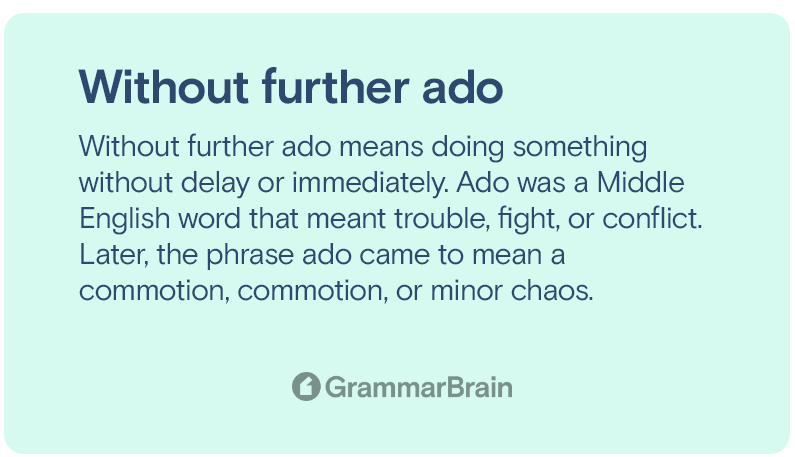Without further ado is an idiom phrase that means without further delay or fuss; immediately. During the olden days, the noun ado was derived from the verb at do. Ado is a medieval English word that meant trouble, fight, or conflict. It was derived from the gerund in phrases like much ado or much to do. It was a Northern English dialect influenced by Norse. The noun ado was used as an infinitive in Scandinavian languages.
In this article, we’ll look at the definition of the idiom ‘Without further ado’ and how to use it correctly with proper examples.

Without further ado definition and meaning
Without further ado means doing something without delay or immediately. Ado was a Middle English word that meant trouble, fight, or conflict. Later, the phrase ado came to mean a commotion, commotion, or minor chaos.
Without further ado, it means without further delay. It is a phrase frequently used by language speakers in front of a large group to imply that the event’s focal point is approaching.
Without further Ado or Further Adieu
Without further ado and without further adieu are the two different phrases but often used for the same meaning .i.e with no delay, but only one is correct. Adieu is a French word for “goodbye.” It’s also a way of wishing someone well before they leave. Without further ado is an idiom that means without further delay.
It is an appropriate phrase to use when speaking with someone or interacting with a group of people via presentation or in person. The phrase “Without further Adieu” is incorrect because it has no meaning. Like a spokesperson says Without further adieu while interacting with their audience, means he wants to end the speech or presentation without saying too many goodbyes. In a logical sense, this is incorrect. However, it is widely accepted.
Proper use of “Without Further Ado”
Without further ado, is generally accompanied by a punctuation mark comma and the action. Such as, “Without further ado, please welcome today’s chief guest.” It is a strategy in which the person provides additional context first before moving on to the important part. Or else begins with a remark that will intrigue the audience’s interest. ”Without further ado, please allow me to introduce Barack Obama”.
Some argue that the phrase demonstrates triviality due to the phrase ado, which also means disturbance. The listeners may believe that you have been using irrelevant words all along. Without further ado, an alternative option for you, or the entire conversion phrase can be removed to avoid the impression that your phrases were inefficient.
Keep in mind that your audience will value clarity of thought more, so convey the important lines, pause, and then move on.
“Without Further Ado” examples in sentences
- Then, without further ado, please enjoy the 1980s edition of top pop bands.
- Without further ado, these are our top brand picks for this month’s magazine cover, listed in chronological order.
- Without further ado, let’s look over each of the 5 biggest metropolitan cities.
- Without further ado, here is your guide to the most attractive qualities of each sign in a relationship.
Conclusion
Without further ado is the correct term that says right away or immediately. The main term is ado in this idiom, which is an abbreviation for “at do.” However, if you need to be certain, you can simply say without further disturbance to convey your message.
Inside this article
Fact checked:
Content is rigorously reviewed by a team of qualified and experienced fact checkers. Fact checkers review articles for factual accuracy, relevance, and timeliness. Learn more.
Core lessons
Glossary
- Abstract Noun
- Accusative Case
- Anecdote
- Antonym
- Active Sentence
- Adverb
- Adjective
- Allegory
- Alliteration
- Adjective Clause
- Adjective Phrase
- Ampersand
- Anastrophe
- Adverbial Clause
- Appositive Phrase
- Clause
- Compound Adjective
- Complex Sentence
- Compound Words
- Compound Predicate
- Common Noun
- Comparative Adjective
- Comparative and Superlative
- Compound Noun
- Compound Subject
- Compound Sentence
- Copular Verb
- Collective Noun
- Colloquialism
- Conciseness
- Consonance
- Conditional
- Concrete Noun
- Conjunction
- Conjugation
- Conditional Sentence
- Comma Splice
- Correlative Conjunction
- Coordinating Conjunction
- Coordinate Adjective
- Cumulative Adjective
- Dative Case
- Determiner
- Declarative Sentence
- Declarative Statement
- Direct Object Pronoun
- Direct Object
- Diction
- Diphthong
- Dangling Modifier
- Demonstrative Pronoun
- Demonstrative Adjective
- Direct Characterization
- Definite Article
- Doublespeak
- False Dilemma Fallacy
- Future Perfect Progressive
- Future Simple
- Future Perfect Continuous
- Future Perfect
- First Conditional
- Irregular Adjective
- Irregular Verb
- Imperative Sentence
- Indefinite Article
- Intransitive Verb
- Introductory Phrase
- Indefinite Pronoun
- Indirect Characterization
- Interrogative Sentence
- Intensive Pronoun
- Inanimate Object
- Indefinite Tense
- Infinitive Phrase
- Interjection
- Intensifier
- Infinitive
- Indicative Mood
- Participle
- Parallelism
- Prepositional Phrase
- Past Simple Tense
- Past Continuous Tense
- Past Perfect Tense
- Past Progressive Tense
- Present Simple Tense
- Present Perfect Tense
- Personal Pronoun
- Personification
- Persuasive Writing
- Parallel Structure
- Phrasal Verb
- Predicate Adjective
- Predicate Nominative
- Phonetic Language
- Plural Noun
- Punctuation
- Punctuation Marks
- Preposition
- Preposition of Place
- Parts of Speech
- Possessive Adjective
- Possessive Determiner
- Possessive Case
- Possessive Noun
- Proper Adjective
- Proper Noun
- Present Participle
- Prefix
- Predicate



